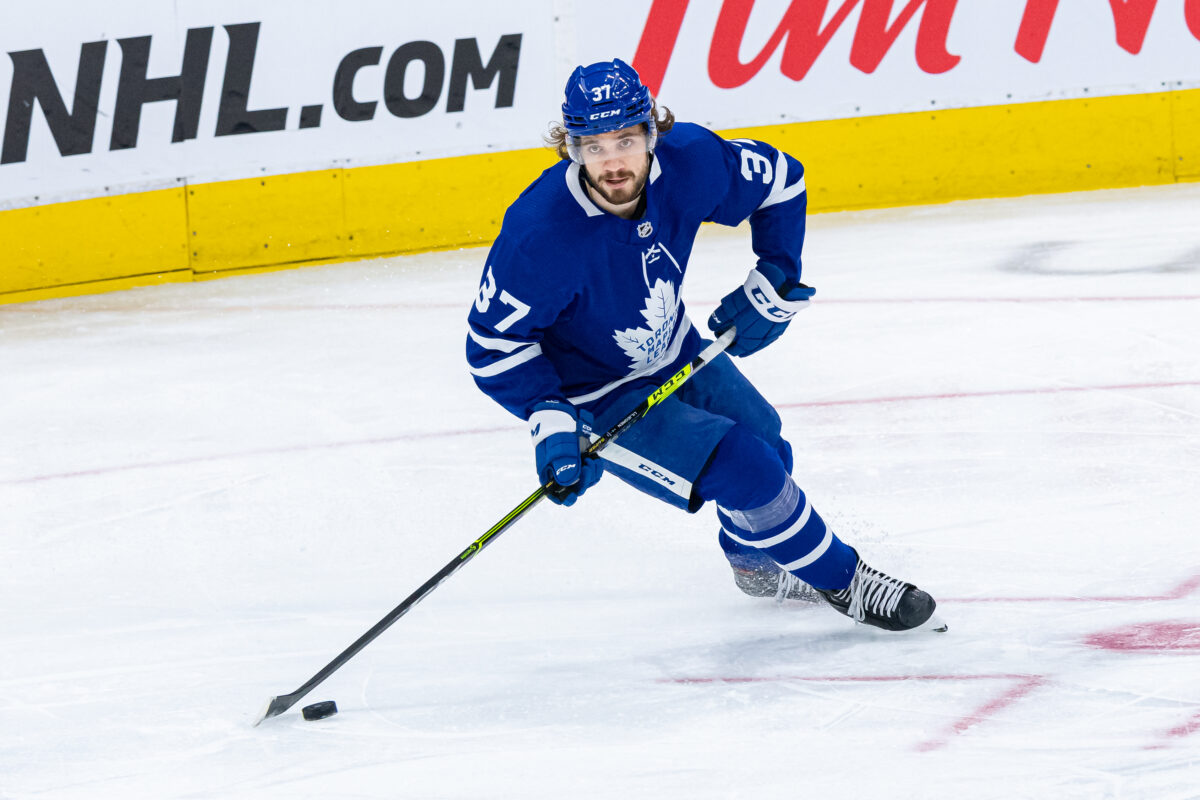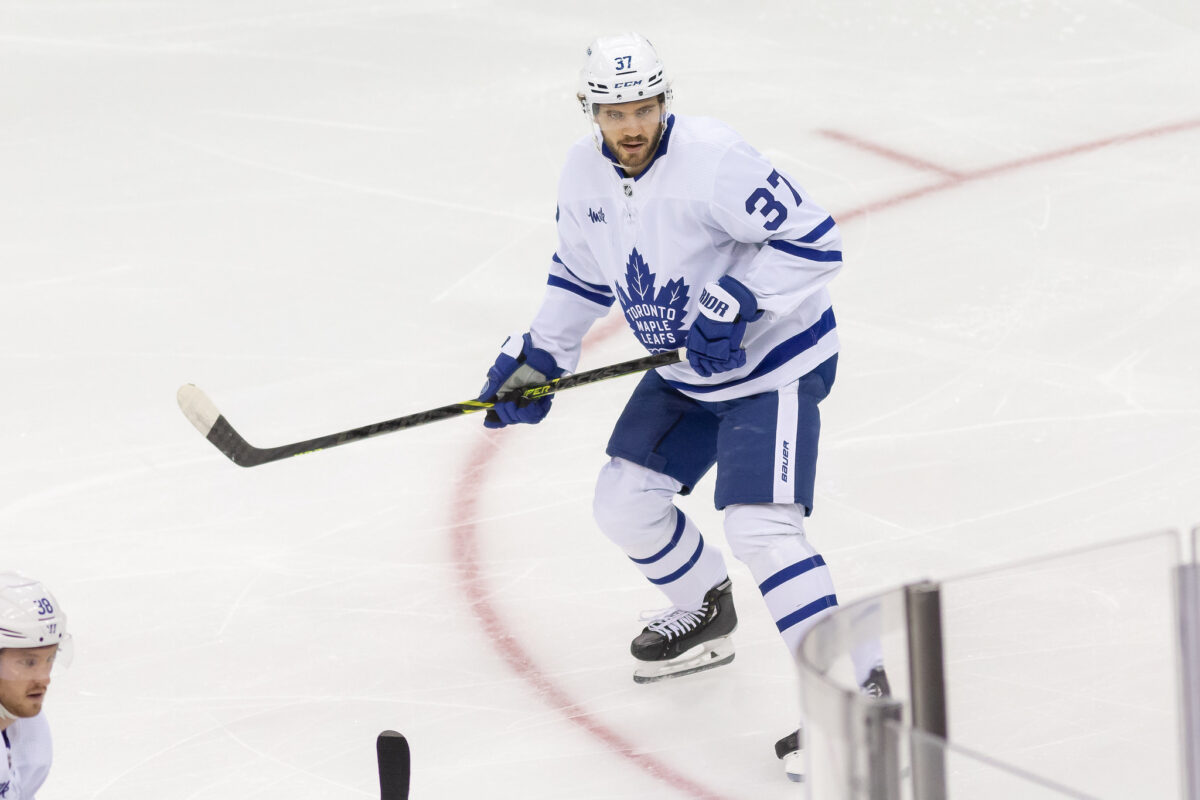Imagine if you will, a right-handed defenceman with size, skill, great footwork, a fantastic first pass and top-four potential for just $3 million. What a deal, eh? If you were the Toronto Maple Leafs, you would be all over that. Now imagine, again, if you will, that he already does play for the Maple Leafs — by God, that’s Timothy Liljegren’s music!
Yes, the Swedish defender taken No. 17 overall by the Maple Leafs in the 2017 NHL Entry Draft has all the tools Toronto is looking for on the blue line. But inconsistency and a Vegas residency in former head coach Sheldon Keefe’s doghouse have left fans and those who follow the club feeling underwhelmed by Liljegren’s performance.
Related: Nicholas Robertson’s Lack of a Trade Market Might Be Good News for His Future
The 25-year-old was scheduled to become a restricted free agent on July 1, but he and the Maple Leafs agreed to terms on a two-year, $6 million deal the day before, giving Liljegren a sizeable raise from the two-year, $2.8 million contract he signed ahead of the 2022-23 season.
Now just weeks ahead of the 2024-25 NHL season, fans are wondering what type of role he will have: is he a top-four defender? Is he merely a trade chip for a forward at some point? Will he ever be more than just “a guy?” Let’s take a look at Liljegren’s 2023-24 season and what he needs to do this season.
Liljegren is Better Than You Think
Despite missing 27 games in 2023-24, mostly to a high-ankle sprain suffered after taking an iffy hit from Boston Bruins’ forward Brad Marchand, Liljegren scored three goals and 20 assists for 23 points, the fourth-highest total on the Maple Leafs’ blue line. It becomes more impressive if you factor in that his 82-game point pace put him at 34, which would have been second behind Morgan Rielly.

Before the injury, Liljegren was starting to look like the type of player coaches and management thought they were getting when they drafted him in 2017 – strong in his own end, crisp passing, an ability to fire pucks with eyes on the net – you felt like you were starting to really see him blossom. But after returning from his ankle injury, you could see him struggle, losing battles in front of the net, getting outworked in the corner, bad attempts at Hail Mary passes that would be intercepted. You wouldn’t blame the coaching staff for wanting to put him in the press box for a game or two as a healthy scratch.
All that changed after Rielly crosschecked Ridly Greig during a game between the two teams on Feb. 10. The incident led to Rielly being suspended for five games, forcing Keefe to give Liljegren a bigger role. In four of the next five contests, Liljegren would average 23:14 of ice time, recording seven assists, three of which came on the power play.
Related: Toronto Maple Leafs 2023-24 Report Card: Timothy Liljegren
That last part is crucial, because when Rielly was out of the lineup, Liljegren became the No. 1 choice on the power play, and the results speak for themselves. The Maple Leafs scored eight power play goals on 17 opportunities while Liljegren was on the first power-play unit, a success rate of 47 percent. The team would end up going 14 for 28 with the man advantage through February, and I don’t need a PhD to tell you that scoring on half of your power play opportunities usually leads to your team winning more games than it loses.
Once Rielly returned and Liljegren’s ice time dipped, those struggles from earlier returned. He found some of his game when paired with trade deadline acquisition Joel Edmundson on the third pair, but once Toronto faced the Bruins in the Stanley Cup Playoffs, it felt like his entire game just dissolved. Those same battles in front, those same bad decisions up the middle of the ice, the things that may not appear on a scoresheet or a spreadsheet, but drive coaches crazy — they were on full display. It had gotten so bad that Keefe and the coaching staff decided to bench Liljegren for Game 4 of the series, a drastic move that saw little pushback on social media at the time.

After a dismal return in Game 5, Liljegren played no more than 15 minutes in either Game 6 or 7, as he was last among Maple Leaf defencemen in ice time through the two contests. It reached a point where Simon Benoit, an undrafted bruiser whom Toronto signed and sent to the minors at the beginning of the season, was getting four or five more minutes of ice time through the playoffs. A player of the same age who came with a far smaller pedigree was outplaying a first-round pick seven years removed for valuable minutes in the Stanley Cup Playoffs.
2024-25 Needs to be Liljegren’s Breakout Year
After extending Liljegren with a two-year contract that will pay him $3 million a season, the Maple Leafs have told both the player and fans that, for the time being, the 6-foot-1 defender is part of the plan. Could the team pair him with recent signing Oliver Ekman-Larsson? Would a pairing with Jake McCabe do the trick? While new head coach Craig Berube is known for pushing his players and demanding they play physical, that doesn’t mean he’s opposed to high skill, and a motivated Liljegren who can push the puck forward while being responsible in his own end could wind up being one of Berube’s secret weapons.
Related: 3 Maple Leafs Storylines Heading Into the 2024-25 Season
There’s a quote from the former head coach from last season that took me way too long to find while putting together this story, but damn it, I found it. It came Jan. 20 after a particularly bad pair of games for Liljegren, who in a 4-2 loss to the Edmonton Oilers played just 15:11 of ice time, then two nights later in a 4-3 win over the Calgary Flames, played a measly 13:59.
Ahead of the final game of the western road trip against the Vancouver Canucks, Keefe said this:
Keefe on Liljegren: A guy we talk about daily in terms of needing & wanting more out of … We got to help him thru it … need Lily to skate, move pucks well & get pucks to the net, defend the rush well & I don’t think he’s done that to the level that we expect or have seen
— Mark Masters (@markhmasters) January 20, 2024
(He’s) a guy we talk about daily in terms of needing and wanting more out of,” Keefe told TSN reporter Mark Masters. “We got to help him through it … (we) need Lily to skate, move pucks well and get pucks to the net, defend the rush well, and I don’t think he’s done that to the level that we expect or have seen.”
A stern criticism, especially when you consider that Keefe was basically Liljegren’s only coach since he came to North America and joined the Toronto Marlies ahead of the 2017-18 season. You start to wonder if whatever Keefe was telling him is actually getting through, and if he’s reached his limit with what he could do with the player.

While writing this story, I reached out to a friend who follows the Maple Leafs closely and asked what their take was on the defenceman.
“I believe his performance thus far has been underwhelming in comparison to the flashes I’ve seen,” they said. “If we don’t blame Keefe for putting big, stable defenders in the lineup over him in the playoffs, then I don’t think we can judge the player when they throw him in cold and with low confidence after being scratched.”
I think that’s a fair assessment. One thing we forget in a market like Toronto is that defenders take time to develop; the old adage of it taking a defenceman 250 regular-season games to really adapt to the NHL can be forgotten in a hockey-crazed environment like the one the Maple Leafs play in, where short-term memories and a lack of patience are more common than not. Maybe in a market with fewer eyeballs, someone like Liljegren could take their time to develop, make mistakes, and not worry about being benched if they turn the puck over.
I have no doubt that Liljegren’s name will be weaved into trade rumours throughout the upcoming season, particularly when the forwards not named Auston Matthews, Mitch Marner or William Nylander are failing to score, and fans are wondering why they can’t trade this first-round pick for a scoring winger.
Almost right away, they’ll move on and wonder why it’s so difficult to find a right-handed defenceman with size, skill, great footwork, a fantastic first pass and top-four potential for around $3 million. Time is a flat circle, just like the rubber discs they pass to one another on the ice.
Not many are better than Liljegren at doing that. Before you criticize him, try not to forget that.
